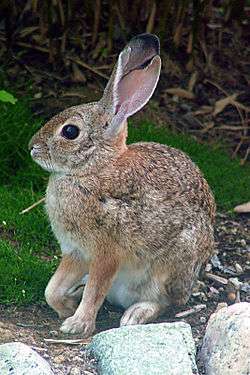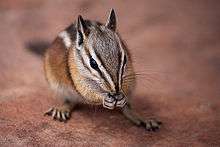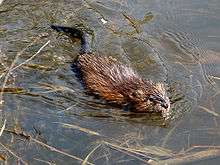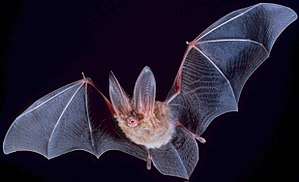List of mammals of Wyoming
There are at least 18 large mammal and 103 small mammal species known to occur in Wyoming.[1]
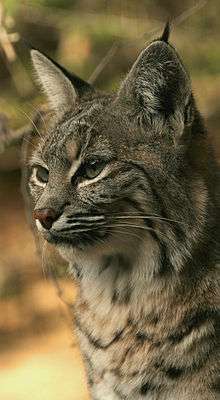
Species are listed by common name, scientific name, typical habitat and occurrence. The common and scientific names come from the American Society of Mammalogists' Wyoming Mammal List.[2]
Large and medium sized mammals
Black bear

Order: Carnivora, Family: Ursidae
Occurrence: Forests, slide areas, alpine meadows
The American black bear (Ursus americanus) is North America's smallest and most common species of bear. It is a generalist animal, being able to exploit numerous different habitats and foodstuffs. The American black bear is listed by the IUCN as being of least concern, due to the species widespread distribution and a large global population estimated to be twice that of all other bear species combined.[3][4]
Bighorn sheep
Order: Artiodactyla, Family: Bovidae
Occurrence: Open mountainous areas
The bighorn sheep (Ovis canadensis)[5] is a species of sheep in North America[6] with large horns. The horns can weigh up to 30 pounds (14 kg), while the sheep themselves weigh up to 300 pounds (140 kg).[7] Recent genetic testing indicates that there are three distinct subspecies of Ovis canadensis, one of which is endangered: Ovis canadensis sierrae.[8]
American bison
Order: Artiodactyla, Family: Bovidae
Occurrence: Eastside parklands and prairies
The American bison (Bison bison) is a North American species of bison, also commonly known as the American buffalo. These bison once roamed the grasslands of North America in massive herds; their range roughly formed a triangle between the Great Bear Lake in Canada's far northwest, south to the Mexican states of Durango and Nuevo León, and east along the western boundary of the Appalachian Mountains.[9][10] Today these bison are much fewer in number, and travel only in small herds.
Bobcat
Order: Carnivora, Family: Felidae
Occurrence: Open forests, brushy areas
The bobcat (Lynx rufus) is a North American mammal of the cat family, Felidae. With twelve recognized subspecies, it ranges from southern Canada to northern Mexico, including most of the continental United States. The bobcat is an adaptable predator that inhabits wooded areas, as well as semi-desert, urban edge, forest edges and swampland environments. It persists in much of its original range and populations are healthy.[11]
Coyote
.jpg)
Order: Carnivora, Family: Canidae
Occurrence: Forests, grasslands
The coyote (/ˈkaɪ.oʊt/ or /kaɪˈoʊtiː/)[12] (Canis latrans), also known as the American jackal or the prairie wolf,[13] is a species of canid found throughout North and Central America, ranging from Panama in the south, north through Mexico, the United States and Canada. It occurs as far north as Alaska and all but the northernmost portions of Canada.[14][15]
Elk

Order: Artiodactyla, Family: Cervidae
Occurrence: Open forests, meadows, fields
The elk or wapiti (Cervus canadensis) is one of the largest species of deer in the world and one of the largest mammals in North America and eastern Asia. In the deer family (Cervidae), only the moose, Alces alces (called an "elk" in Europe), is larger, and Cervus unicolor (the sambar deer) can rival the C. canadensis elk in size. Elk range in forest and forest-edge habitat, feeding on grasses, plants, leaves, and bark.[16]
Gray fox
Order: Carnivora, Family: Canidae
Occurrence: Deciduous forests, cottonwood riparian, basin-prairie shrublands, sagebrush-grasslands, riparian shrub, grasslands, agricultural areas, rock outcrops, roadside/railroad banks.
The gray fox (Urocyon cinereoargenteus) ranges throughout most of the southern half of North America from southern Canada to the northern part of South America (Venezuela and Colombia).[17][18]
Gray wolf
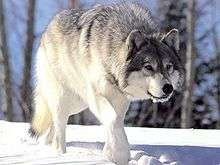
Order: Carnivora, Family: Canidae
Occurrence: Coniferous forests
The gray wolf (Canis lupus), often known simply as the wolf, is the largest wild member of the family Canidae. It is an ice age survivor originating during the Late Pleistocene around 300,000 years ago.[19] DNA sequencing and genetic drift studies reaffirm that the gray wolf shares a common ancestry with the domestic dog (Canis lupus familiaris).[20] Although certain aspects of this conclusion have been questioned, the main body of evidence confirms it. A number of other gray wolf subspecies have been identified, though the actual number of subspecies is still open to discussion. Gray wolves are typically apex predators in the ecosystems they occupy.[21]
Canada lynx
Order: Carnivora, Family: Felidae
Occurrence: Coniferous forests
The Canada lynx (Lynx canadensis) is a North American mammal of the cat family, Felidae. It is a close relative of the Eurasian lynx (Lynx lynx). Some authorities regard both as conspecific. However, in some characteristics the Canadian lynx is more like the bobcat (Lynx rufus) than the Eurasian lynx. With the recognized subspecies, it ranges across Canada and into Alaska as well as some parts of the northern United States.[22]
Moose
Order: Artiodactyla, Family: Cervidae
Occurrence: Coniferous forests, lakes, slow streams, marshy areas
The moose (North America) or common European elk (Europe) (Alces alces) is the largest extant species in the deer family. Moose are distinguished by the palmate antlers of the males; other members of the family have antlers with a "twig-like" configuration. Moose typically inhabit boreal and mixed deciduous forests of the Northern Hemisphere in temperate to subarctic climates.[23]
Mountain goat
Order: Artiodactyla, Family: Bovidae
Occurrence: High peaks and meadows
The mountain goat (Oreamnos americanus), also known as the Rocky Mountain goat, is a large-hoofed mammal found only in North America. Despite its vernacular name, it is not a member of Capra, the genus of true goats. It resides at high elevations and is a sure-footed climber, often resting on rocky cliffs that predators cannot reach.[24]
Mountain lion
Order: Carnivora, Family: Felidae
Occurrence: Coniferous forests
The cougar (Puma concolor), also known as puma, mountain lion, mountain cat, catamount or panther, depending on the region, is a mammal of the family Felidae, native to the Americas. This large, solitary cat has the greatest range of any large wild terrestrial mammal in the Western Hemisphere, extending from Yukon in Canada to the southern Andes of South America. An adaptable, generalist species, the cougar is found in every major American habitat type. It is the second heaviest cat in the American continents after the jaguar. Although large, the cougar is most closely related to smaller felines.[25]
Mule deer
Order: Artiodactyla, Family: Cervidae
Occurrence: Open forests, meadows, often at high elevations
The mule deer (Odocoileus hemionus) is a deer whose habitat is in the western half of North America. It gets its name from its large mule-like ears. Adult male mule deer are called bucks, adult females are called does, and young of both sexes are called fawns. The black-tailed deer is considered by some a distinct species though it is classified as a subspecies of the mule deer. Unlike its cousin, the white-tailed deer, mule deer are generally more associated with the land west of the Missouri River. The most noticeable differences between whitetails and mule deer are the color of their tails and configuration of their antlers. The mule deer's tail is black tipped.[26]
Pronghorn
Order: Artiodactyla, Family: Antilocapridae
Occurrence: Basin-prairie and mountain-foothills, shrublands, eastern great plains and great basin-foothills grasslands, sagebrush-grasslands
The pronghorn (Antilocapra americana), is a species of artiodactyl mammal native to interior western and central North America. Though not a true antelope, it is often known colloquially in North America as the prong buck, pronghorn antelope or simply antelope,[27] as it closely resembles the true antelopes of the Old World and fills a similar ecological niche due to convergent evolution.[28] It is the only surviving member of the family Antilocapridae.[29][30]
Red fox

Order: Carnivora, Family: Canidae
Occurrence: Grasslands, open forest
The red fox (Vulpes vulpes) is a small canid native to much of North America and Eurasia, as well as northern Africa. It is the most recognizable species of fox and in many areas it is referred to simply as "the fox". As its name suggests, its fur is predominantly reddish brown, but there is a naturally occurring gray morph known as the "silver" fox. The red fox is by far the most widespread and abundant species of fox, found in almost every single habitat in the Northern Hemisphere, from the coastal marshes of United States, to the alpine tundras of Tibetan Plateau.[31]
Swift fox

Order: Carnivora, Family: Canidae
Occurrence: Short-grass prairies and deserts
The swift fox (Vulpes velox) is a small light orange-tan fox around the size of a domestic cat found in the western grasslands of North America, such as Colorado, New Mexico and Texas.[32] It also lives in Manitoba, Saskatchewan and Alberta in Canada, where it was previously extirpated.[33] It is closely related to the kit fox and the two species are sometimes known as subspecies of Vulpes velox because hybrids of the two species occur naturally where their ranges overlap.
The swift fox lives primarily in short-grass prairies and deserts. Due to predator control programs in the 1930s, it was considered extinct in Canada for some time, but reintroduction programs have been successful in reintroducing the species. Due to stable populations elsewhere, the species is considered by the IUCN to be of least concern.[33][34]
White-tailed deer
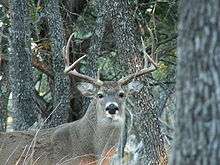
Order: Artiodactyla, Family: Cervidae
Occurrence: Coniferous forests, meadows, creek and river bottoms
The white-tailed deer (Odocoileus virginianus), also known as the Virginia deer, or simply as the whitetail, is a medium-sized deer native to the United States (all but five of the states), Canada, Mexico, Central America, and in South America as far south as Peru. The species is most common east of the Rocky Mountains, and is absent from much of the western United States, including Nevada, Utah, California, Hawaii, and Alaska (though its close relatives, the mule deer and black-tailed deer, can be found there). It does, however, survive in aspen parklands and deciduous river bottomlands within the central and northern Great Plains, and in mixed deciduous riparian corridors, river valley bottomlands, and lower foothills of the northern Rocky Mountain regions from Wyoming to southeastern British Columbia.[35]
Small mammals
Raccoons
From the Atlas of Birds, Mammals, Amphibians, and Reptiles in Wyoming:[36]
Order: Carnivora, Family: Procyonidae
Badgers and weasels
From the Atlas of Birds, Mammals, Amphibians, and Reptiles in Wyoming:[37]

Order: Carnivora, Family: Mustelidae
- American badger, Taxidea taxus, grasslands
- Fisher, Martes pennanti, coniferous forests
- American marten, Martes americana, coniferous forests
- American mink, Neovison vison, creek and lake edges
- North American river otter, Lontra canadensis, rivers, lakes, ponds
- Least weasel, Mustela nivalis, open forests and grasslands
- Long-tailed weasel, Mustela frenata, open forests and meadows
- Short-tailed weasel, Mustela erminea, coniferous forests and meadows
- Wolverine, Gulo gulo, coniferous forests and alpine meadows
- Black-footed ferret, Mustela nigripes
Skunks
From the Atlas of Birds, Mammals, Amphibians, and Reptiles in Wyoming:[38]
Order: Carnivora, Family: Mephitidae
- Striped skunk, Mephitis mephitis, open forests and grasslands
- Western spotted skunk, Spilogale gracilis
- Eastern spotted skunk, Spilogale putorius
Hares and rabbits
From the Atlas of Birds, Mammals, Amphibians, and Reptiles in Wyoming:[39]
Order: Lagomorpha, Family: Leporidae
- Snowshoe hare, Lepus americanus, coniferous forests
- White-tailed jackrabbit, Lepus townsendii, grasslands
- Mountain cottontail, Sylvilagus nuttallii, forests, brushy areas
- Black-tailed jackrabbit, Lepus californicus
- Desert cottontail, Sylvilagus audubonii
- Eastern cottontail, Sylvilagus floridanus
- Pygmy rabbit, Brachylagus idahoensis
Pikas
From the Atlas of Birds, Mammals, Amphibians, and Reptiles in Wyoming:[40]
Order: Lagomorpha, Family: Ochotonidae
- American pika, Ochotona princeps, rocky slopes
Shrews
From the Atlas of Birds, Mammals, Amphibians, and Reptiles in Wyoming:[41]
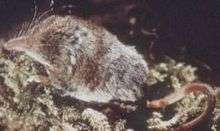
Order: Eulipotyphla, Family: Soricidae
- Dusky shrew, Sorex monticolus, higher elevation coniferous forests
- Masked shrew, Sorex cinereus, coniferous forests, meadows, ponds and stream edges
- American water shrew, Sorex palustris, stream edges
- Pygmy shrew, Sorex hoyi, dry open coniferous forests
- Vagrant shrew, Sorex vagrans, moist forests and grasslands, marsh and stream edges
- Dwarf shrew, Sorex nanus
- Hayden's shrew, Sorex haydeni
- Merriam's shrew, Sorex merriami
- Preble's shrew, Sorex preblei
Beaver
From the Atlas of Birds, Mammals, Amphibians, and Reptiles in Wyoming:[42]
Order: Rodentia, Family: Castoridae
- Beaver, Castor canadensis, ponds, streams, lakes
Squirrels
From the Atlas of Birds, Mammals, Amphibians, and Reptiles in Wyoming:[43]
Order: Rodentia, Family: Sciuridae
- Least chipmunk, Tamias minimus, high open forests, brushy, rocky areas, alpine meadows
- Yellow-pine chipmunk, Tamias amoenus, open forests, brushy, rocky areas
- Cliff chipmunk, Tamias dorsalis
- Uinta chipmunk, Tamias umbrinus
- Yellow-bellied marmot, Marmota flaviventris, open rocky foothills, talus slopes
- Northern flying squirrel, Glaucomys sabrinus, coniferous forests, nocturnal
- Eastern fox squirrel, Sciurus niger
- Red squirrel, Tamiasciurus hudsonicus
- Abert's squirrel, Sciurus aberti
- Thirteen-lined ground squirrel, Spermophilus tridecemlineatus, grasslands
- Golden-mantled ground squirrel, Spermophilus lateralis, high open forests, rocky areas
- Uinta ground squirrel, Spermophilus armatus
- Wyoming ground squirrel, Spermophilus elegans
- Spotted ground squirrel, Spermophilus spilosoma
- Black-tailed prairie dog, Cynomys ludovicianus
- White-tailed prairie dog, Cynomys leucurus
Pocket mice and kangaroo rats
From the Atlas of Birds, Mammals, Amphibians, and Reptiles in Wyoming:[44]
Order: Rodentia, Family: Heteromyidae
- Plains pocket mouse, Perognathus flavescens
- Great Basin pocket mouse, Perognathus parvus
- Hispid pocket mouse, Chaetodipus hispidus
- Olive-backed pocket mouse, Perognathus fasciatus
- Ord's kangaroo rat, Dipodomys ordii
- Silky pocket mouse, Perognathus flavus
Pocket gophers
From the Atlas of Birds, Mammals, Amphibians, and Reptiles in Wyoming:[45]
Order: Rodentia, Family: Geomyidae
- Northern pocket gopher, Thomomys talpoides, meadows
- Idaho pocket gopher, Thomomys idahoensis
- Wyoming pocket gopher, Thomomys clusius
- Plains pocket gopher, Geomys bursarius
Mice
From the Atlas of Birds, Mammals, Amphibians, and Reptiles in Wyoming:[46]
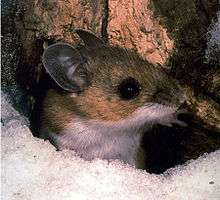
Order: Rodentia, Family: Cricetidae
- Deer mouse, Peromyscus maniculatus, forests, grasslands, alpine meadows
- Northern grasshopper mouse, Onychomys leucogaster
- Western harvest mouse, Reithrodontomys megalotis
- Plains harvest mouse, Reithrodontomys montanus
- White-footed mouse, Peromyscus leucopus
- Pinyon mouse, Peromyscus truei
- Canyon mouse, Peromyscus crinitus
Jumping mice
From the Atlas of Birds, Mammals, Amphibians, and Reptiles in Wyoming:[47]
Order: Rodentia, Family: Dipodidae
- Western jumping mouse, Zapus princeps, grasslands, alpine meadows
- Meadow jumping mouse, Zapus hudsonius
Muskrats, voles and woodrats
From the Atlas of Birds, Mammals, Amphibians, and Reptiles in Wyoming:[48]
Order: Rodentia, Family: Cricetidae
- Muskrat, Ondatra zibethicus, streams, lakes, marshy areas
- Heather vole, Phenacomys intermedius, coniferous forests, alpine meadows
- Long-tailed vole, Microtus longicaudus, coniferous forests, grasslands
- Meadow vole, Microtus pennsylvanicus, open forests, meadows, along streams, marshy areas
- Southern red-backed vole, Clethrionomys gapperi, coniferous forests
- Water vole, Microtus richardsoni, high elevation stream and lake edges
- Montane vole, Microtus montanus
- Prairie vole, Microtus ochrogaster
- Sagebrush vole, Lemmiscus curtatus
- Bushy-tailed woodrat, Neotoma cinerea, rocky areas, old buildings
Porcupines
Order: Rodentia, Family: Erethizontidae
- North American porcupine, Erethizon dorsatum, coniferous forests[49]
Bats
From the Atlas of Birds, Mammals, Amphibians, and Reptiles in Wyoming:[50]
Order: Chiroptera, Family: Vespertilionidae
- Big brown bat, Eptesicus fuscus, coniferous forests, often around buildings, caves
- Hoary bat, Lasiurus cinereus, coniferous forests, mostly nocturnal
- Little brown bat, Myotis lucifugus, coniferous forests, often around buildings, caves, nocturnal
- Long-eared myotis, Myotis evotis, coniferous forests, meadows, nocturnal
- Long-legged bat, Myotis volans, coniferous forests, meadows, nocturnal
- Silver-haired bat, Lasionycteris noctivagans, coniferous forests, meadows, nocturnal
- California myotis, Myotis californicus
- Eastern red bat, Lasiurus borealis
- Fringed myotis, Myotis thysanodes
- Northern myotis, Myotis septentrionalis
- Pallid bat, Antrozous pallidus
- Spotted bat, Euderma maculatum
- Townsend's big-eared bat, Corynorhinus townsendii
- Western small-footed myotis, Myotis ciliolabrum
- Yuma myotis, Myotis yumanensis
- Eastern pipistrelle, Pipistrellus subflavus
- Brazilian free-tailed bat, Tadarida brasiliensis
- Big free-tailed bat, Nyctinomops macrotis
Exotic species, not native to Wyoming
Feral horse
The wild horse (Equus ferus) is a species of the genus Equus, which includes as subspecies both the domesticated horse as well as the undomesticated tarpan and Przewalski's horse.[51] The term "wild horse" is also used colloquially to refer to free roaming herds of feral horses such as the mustang in the United States, the Brumby in Australia, and many others. These feral horses are untamed members of the domestic horse subspecies (Equus ferus caballus), and should not be confused with the two truly "wild" horse subspecies.[52]
Small mammals
- Eastern gray squirrel, Sciurus carolinensis[53]
- Virginia opossum, Didelphis virginiana[54]
- House mouse, Mus musculus[55]
- Norway rat, Rattus norvegicus[55]
Further reading
- Clark, Tim W.; Stromberg, Mark R. (1987). Mammals in Wyoming. Lawrence, KS: University of Kansas. ISBN 0-89338-026-1.
- Negus, Norman C.; James S. Findley (1959). Mammals of Jackson Hole, Wyoming. American Society of Mammalogists.
- White, John A. (1953). Geographic Distribution and Taxonomy of the Chipmunks of Wyoming. Lawrence, KS: University of Kansas.
Notes
- Cerovski, A.O.; M. Grenier; B. Oakleaf; L. Van Fleet; S. Patla (2004). Atlas of Birds, Mammals, Amphibians, and Reptiles in Wyoming (PDF). Lander, WY: Wyoming Game and Fish Department Nongame Program.
- "Mammals of Wyoming". American Society of Mammalogists. Retrieved 28 December 2011.
- Garshelis, D.L.; Crider, D. & van Manen, F. (2008). "Ursus americanus". IUCN Red List of Threatened Species. 2008. Retrieved 27 January 2009.CS1 maint: ref=harv (link)
- "Atlas of Birds, Mammals, Amphibians, and Reptiles in Wyoming-Black Bear" (PDF). Wyoming Game and Fish Department Nongame Program. p. 147. Retrieved 28 December 2011.
- "Ovis canadensis". Integrated Taxonomic Information System. Retrieved 18 March 2006.
- Grubb, P. (2005). Wilson, D.E.; Reeder, D.M. (eds.). Mammal Species of the World: A Taxonomic and Geographic Reference (3rd ed.). Johns Hopkins University Press. ISBN 978-0-8018-8221-0. OCLC 62265494.
- Bighorn Sheep
- "Atlas of Birds, Mammals, Amphibians, and Reptiles in Wyoming-Bighorn Sheep" (PDF). Wyoming Game and Fish Department Nongame Program. p. 153. Retrieved 28 December 2011.
- "Archived copy". Archived from the original on 24 July 2009. Retrieved 27 February 2010.CS1 maint: archived copy as title (link)
- "Atlas of Birds, Mammals, Amphibians, and Reptiles in Wyoming-Bison" (PDF). Wyoming Game and Fish Department Nongame Program. p. 153. Retrieved 28 December 2011.
- "Atlas of Birds, Mammals, Amphibians, and Reptiles in Wyoming-Bobcat" (PDF). Wyoming Game and Fish Department Nongame Program. p. 151. Retrieved 28 December 2011.
- coyote - Definitions from Dictionary.com
- prairie wolf. The Columbia Encyclopedia, Sixth Edition. 2001-07 Archived 16 October 2008 at the Wayback Machine
- "Canis latrans". Animal Diversity Web. Retrieved 15 August 2007.
- "Atlas of Birds, Mammals, Amphibians, and Reptiles in Wyoming-Coyote" (PDF). Wyoming Game and Fish Department Nongame Program. p. 145. Retrieved 28 December 2011.
- "Atlas of Birds, Mammals, Amphibians, and Reptiles in Wyoming-Elk" (PDF). Wyoming Game and Fish Department Nongame Program. p. 152. Retrieved 28 December 2011.
- Wozencraft, W.C. (2005). "Order Carnivora". In Wilson, D.E.; Reeder, D.M (eds.). Mammal Species of the World: A Taxonomic and Geographic Reference (3rd ed.). Johns Hopkins University Press. pp. 532–628. ISBN 978-0-8018-8221-0. OCLC 62265494.
- "Atlas of Birds, Mammals, Amphibians, and Reptiles in Wyoming-Gray Fox" (PDF). Wyoming Game and Fish Department Nongame Program. p. 146. Retrieved 28 December 2011.
- Nowak, R. 1992. Wolves: The great travelers of evolution. International Wolf 2(4):3 - 7.
- Jeffrey Cohn (December 1997). "How Wild Wolves Became Domestic Dogs". BioScience. Oxford University Press on behalf of the American Institute of Biological Sciences. 47 (11): 725–728. doi:10.2307/1313093. JSTOR 1313093.
- "Atlas of Birds, Mammals, Amphibians, and Reptiles in Wyoming-Gray Wolf" (PDF). Wyoming Game and Fish Department Nongame Program. p. 146. Retrieved 28 December 2011.
- "Atlas of Birds, Mammals, Amphibians, and Reptiles in Wyoming-Canada Lynx" (PDF). Wyoming Game and Fish Department Nongame Program. p. 151. Retrieved 28 December 2011.
- "Atlas of Birds, Mammals, Amphibians, and Reptiles in Wyoming-Moose" (PDF). Wyoming Game and Fish Department Nongame Program. p. 152. Retrieved 28 December 2011.
- "Atlas of Birds, Mammals, Amphibians, and Reptiles in Wyoming-Mountain Goat" (PDF). Wyoming Game and Fish Department Nongame Program. p. 153. Retrieved 28 December 2011.
- "Atlas of Birds, Mammals, Amphibians, and Reptiles in Wyoming-Mountain Lion" (PDF). Wyoming Game and Fish Department Nongame Program. p. 151. Retrieved 28 December 2011.
- "Atlas of Birds, Mammals, Amphibians, and Reptiles in Wyoming-Mule Deer" (PDF). Wyoming Game and Fish Department Nongame Program. p. 152. Retrieved 28 December 2011.
- Caton, J. D. (1876). The American Antelope, or Prong Buck The American Naturalist 10 (4): 193–205.
- Farb, Peter (1970). Ecology. Time Life Books. pp. 126, 136
- Smithsonian Institution. North American Mammals: Pronghorn Antilocapra americana
- "Atlas of Birds, Mammals, Amphibians, and Reptiles in Wyoming-Pronghorn" (PDF). Wyoming Game and Fish Department Nongame Program. p. 153. Retrieved 28 December 2011.
- "Atlas of Birds, Mammals, Amphibians, and Reptiles in Wyoming-Red Fox" (PDF). Wyoming Game and Fish Department Nongame Program. p. 146. Retrieved 28 December 2011.
- Wozencraft, W.C. (2005). "Order Carnivora". In Wilson, D.E.; Reeder, D.M (eds.). Mammal Species of the World: A Taxonomic and Geographic Reference (3rd ed.). Johns Hopkins University Press. pp. 532–628. ISBN 978-0-8018-8221-0. OCLC 62265494.
- Moehrenschlager, A.; Sovada, M. & Members of the IUCN SSC Canid Specialist Group - North America Regional Section (2008). "Vulpes velox". IUCN Red List of Threatened Species. 2008. Retrieved 22 March 2009.CS1 maint: ref=harv (link)
- "Atlas of Birds, Mammals, Amphibians, and Reptiles in Wyoming-Swift Fox" (PDF). Wyoming Game and Fish Department Nongame Program. p. 146. Retrieved 28 December 2011.
- "Atlas of Birds, Mammals, Amphibians, and Reptiles in Wyoming-White-tailed Deer" (PDF). Wyoming Game and Fish Department Nongame Program. p. 152. Retrieved 28 December 2011.
- "Atlas of Birds, Mammals, Amphibians, and Reptiles in Wyoming-Raccoons" (PDF). Wyoming Game and Fish Department Nongame Program. p. 147. Retrieved 23 November 2010.
- "Atlas of Birds, Mammals, Amphibians, and Reptiles in Wyoming-Badgers and Weasels" (PDF). Wyoming Game and Fish Department Nongame Program. pp. 148–150. Retrieved 23 November 2010.
- "Atlas of Birds, Mammals, Amphibians, and Reptiles in Wyoming-Skunks" (PDF). Wyoming Game and Fish Department Nongame Program. p. 150. Retrieved 23 November 2010.
- "Atlas of Birds, Mammals, Amphibians, and Reptiles in Wyoming-Hares and Rabbits" (PDF). Wyoming Game and Fish Department Nongame Program. pp. 131–133. Retrieved 23 November 2010.
- "Atlas of Birds, Mammals, Amphibians, and Reptiles in Wyoming-Pikas" (PDF). Wyoming Game and Fish Department Nongame Program. p. 131. Retrieved 28 December 2011.
- "Atlas of Birds, Mammals, Amphibians, and Reptiles in Wyoming-Shrews" (PDF). Wyoming Game and Fish Department Nongame Program. pp. 124–126. Retrieved 28 December 2011.
- "Atlas of Birds, Mammals, Amphibians, and Reptiles in Wyoming-Beaver" (PDF). Wyoming Game and Fish Department Nongame Program. p. 140. Retrieved 28 December 2011.
- "Atlas of Birds, Mammals, Amphibians, and Reptiles in Wyoming-Squirrels" (PDF). Wyoming Game and Fish Department Nongame Program. pp. 133–137. Retrieved 28 December 2011.
- "Atlas of Birds, Mammals, Amphibians, and Reptiles in Wyoming-Pocket Mice and Kangaroo Rats" (PDF). Wyoming Game and Fish Department Nongame Program. pp. 138–39. Retrieved 28 December 2011.
- "Atlas of Birds, Mammals, Amphibians, and Reptiles in Wyoming-Pocket Gophers" (PDF). Wyoming Game and Fish Department Nongame Program. pp. 137–138. Retrieved 23 November 2010.
- "Atlas of Birds, Mammals, Amphibians, and Reptiles in Wyoming-Mice" (PDF). Wyoming Game and Fish Department Nongame Program. pp. 140–41. Retrieved 23 November 2010.
- "Atlas of Birds, Mammals, Amphibians, and Reptiles in Wyoming-Jumping Mice" (PDF). Wyoming Game and Fish Department Nongame Program. p. 145. Retrieved 23 November 2010.
- "Atlas of Birds, Mammals, Amphibians, and Reptiles in Wyoming-Muskrats, Voles and Woodrats" (PDF). Wyoming Game and Fish Department Nongame Program. pp. 142–144. Retrieved 23 November 2010.
- "Atlas of Birds, Mammals, Amphibians, and Reptiles in Wyoming-Porcupine" (PDF). Wyoming Game and Fish Department Nongame Program. p. 145. Retrieved 28 December 2011.
- "Atlas of Birds, Mammals, Amphibians, and Reptiles in Wyoming-Bats" (PDF). Wyoming Game and Fish Department Nongame Program. pp. 126–131. Retrieved 28 December 2011.
- Grubb, P. (2005). "Order Perissodactyla". In Wilson, D.E.; Reeder, D.M (eds.). Mammal Species of the World: A Taxonomic and Geographic Reference (3rd ed.). Johns Hopkins University Press. p. 630–631. ISBN 978-0-8018-8221-0. OCLC 62265494.
- "Pryor Mountain Wild Mustang Center". Retrieved 28 December 2011.
- "Atlas of Birds, Mammals, Amphibians, and Reptiles in Wyoming-Eastern Gray Squirrel" (PDF). Wyoming Game and Fish Department Nongame Program. p. 136. Retrieved 28 December 2011.
- "Atlas of Birds, Mammals, Amphibians, and Reptiles in Wyoming-Virginia Opossum" (PDF). Wyoming Game and Fish Department Nongame Program. p. 124. Retrieved 28 December 2011.
- "Atlas of Birds, Mammals, Amphibians, and Reptiles in Wyoming-Norway Rat" (PDF). Wyoming Game and Fish Department Nongame Program. p. 144. Retrieved 28 December 2011.

